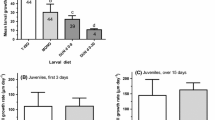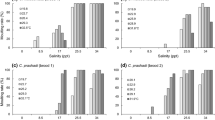Abstract
The variable duration of the pelagic phase of metamorphically competent larvae of benthic marine invertebrates is set by an interaction between environmental factors and larval traits that together influence the chance that a larva will encounter and respond to a suitable settlement site. In the Hawaiian aeolid nudibranch Phestilla sibogae Bergh, an extended competent larval phase resulted in a cascade of negative effects on larval and post-larval life-history traits. When raised as fed (i.e., facultatively planktotrophic) larvae, an extended larval period resulted in lower larval survival, slightly lower metamorphic success, and delayed reproduction. When raised as unfed (i.e., lecithotrophic) larvae, an extended larval period resulted in lower larval and post-larval weights, survival, metamorphic success, and reproductive output, and also resulted in a longer juvenile period and delayed reproduction. The chance nature of locating a settlement site generally spreads these negative effects over all larvae of a cohort, and so balances the relative fitness of the genetic lineages within a population.
Similar content being viewed by others
References
Ament, A. S. (1979). Geographic variation in relation to life history in three species of the marine gastropod genus Crepidula: growth rates of newly hatched larvae and juvenile. In: Stancyk, S. E. (ed.) Reproductive ecology of marine invertebrates. University of South Carolina Press, Columbia, p. 61–76
Bayne, B. L. (1964). The responses of the larvae of Mytilus edulis (L.) to light and to gravity. Oikos 15: 162–174
Bayne, B. L. (1965). Growth and the delay of metamorphosis of the larvae of Mytilus edulis (L.) Ophelia 2: 1–47
Berg, C. J., Jr., Alatalo, F. P. (1982). Reproductive strategies of bivalve mollusks from deep sea hydrothermal vents and intertidal sulfide rich environments. Biol. Bull. mar. biol. Lab., Woods Hole 163: p. 397
Birkeland, C., Chia, F. S., Strathamann, R. R. (1971). Development, substratum selection, delay of metamorphosis and growth in the seastar, Mediaster aequalis Stimpson. Biol. Bull. mar. biol. Lab., Woods Hole 141: 99–108
Bonar, D. B. (1978). Regeneration in sea urchin larvae. Am Zool. 18: p. 581
Bonar, D. B. (1979). Regeneration of larval and potential adult tissues in sea urchin larvae. Am. Zool. 19: p. 926
Domanski, P. A. (1984). Giant larvae: prolonged planktonic larval phase in the asteroid Luidia sarsi. Mar. Biol. 80: 189–195
Doyle, R. W. (1975). Settlement of planktonic larvae: a theory of habitat selection in varying environments. Am Nat. 109: 113–126
Emlet, R. B. (1986a). Facultative planktotrophy in the tropical echinoid Clypeaster rosaceus (L.) and a comparison with obligate planktotrophy in Clypeaster subdepressus (Gray) (Clypeasterioda: Echinoidea). J. exp. mar. Biol. Ecol. 95: 183–202
Emlet, R. B. (1986b). Larval production, dispersal and growth in a fjord: a case study on larvae of the sand dollar Dendraster excentricus. Mar. Ecol. Prog. Ser. 31: 245–254
Hannan, C. A. (1984). Planktonic larvae may act like passive particles in turbulent near-bottom flow. Limnol. Oceangr. 29: 1108–1116
Highsmith, R. C., Emlet, R. B. (1986). Delayed metamorphosis: effects on growth and survival of juvenile sand dollars (Echinoidea: Clypeasteroida) Bull. mar. Sci. 39: 347–361
Hinegardner, R. T. (1969). Growth and development of the laboratory cultured sea urchin. Biol. Bull. mar. biol. Lab., Woods Hole 137: 465–475
Holehan, A. M., Merry, B. J. (1986). The experimental manipulation of ageing by diet. Biol. Rev. 61: 329–368
Kempf, S. C. (1981). Long-lived larvae of the gastropod Aplysia juliana: do they disperse and metamorphose or just slowly fade away? Mar. Ecol. Prog. Ser. 6: 61–65
Kempf, S. C., Hadfield, M. G. (1985). Planktotrophy by the lecithotrophic larvae of a nudibranch, Phestilla sibogae (Gastropoda). Biol. Bull. mar. biol. Lab., Woods Hole 169: 119–130
Knight-Jones, E. W. (1953). Decreased discrimination during setting after prolonged planktonic life in larvae of Spirorbis borealis (Surpulidae). J. mar. biol. Ass. U.K. 32: 337–345
Knowlton, R. E. (1973). Larval development of the snapping shrimp Alpheus heterochaelis Say, reared in the laboratory. J. nat. Hist. 7: 273–306
Levin, L. A., Caswell, H., DePatra, K. D., Creed, E. L. (1987). Demographic consequences of larval development mode: planktotrophic versus lecithotrophy in Streblospio benedictii. Ecology 68: 1877–1886
Lewontin, R. C. (1974). The genetic basis of evolutionary change. Columbia University Press, New York
Losee, E. (1979). Relationship between larval and spat growth rates in the oyster (Crassostrea virginica). Aquaculture, Amsterdam 16: 123–126
Lucas, M. I., Walker, G., Holland, D. L., Crisp, D. J. (1979). An energy budget for the free-swimming and metamorphosing larvae of Balanus balanoides (Crustacea: Cirripedia). Mar. Biol. 55: 221–229
Miller, S. E., Hadfield, M. G. (1986). Ontogeny of phototaxis and metamorphic competence in larvae of the nudibranch Phestilla sibogae Bergh (Gastropoda: Opisthobranchia). J. exp. mar. Biol. Ecol. 97: 95–112
Miller, S. E., Hadfield, M. G. (1990). Developmental arrest during larval life and life-span extension in a marine mollusc. Science, N.Y. 248: 356–358
Newkirk, G. F., Haley, L. E., Waugh, D. L., Doyle, R. (1977). Genetics of larvae and spat growth rate in the oyster Crassostrea virginica. Mar. Biol. 41: 49–52
Obrebski, S. (1979). Larval colonizing strategies in marine benthic invertebrates. Mar. Ecol. Prog. Ser. 1: 293–300
Palumbi, S. R., Wilson, A. C. (1990). Mitochondrial DNA diversity in the sea urchins Stronglyocentrotus purpuratus and S. droebachiensis. Evolution 44: 403–415
Palmer, A. R., Strathmann, R. R. (1981). Scale of dispersal in varying environments and its implications for life histories of marine invertebrates. Oecologia 48: 308–318
Pechenik, J. A. (1986). Field evidence for delayed metamorphosis of larval gastropods: Crepidula plana Say, C. fornicata (L.), and Bittium alternatum (Say). J. exp. mar. Biol. Ecol. 97: 313–319
Pechenik, J. A., Eyster, L. S. (1989). Influence of delayed metamorphosis on the growth and metabolism of young Crepidula fornicata (Gastropoda) juveniles. Biol. Bull. mar. biol. Lab., Woods Hole 176: 14–24
Pechenik, J. A., Lima, G. M. (1984). Relationship between growth, differentiation, and lenght of larval life for individually reared larvae of the marine gastropod, Crepidula fornicata. Biol. Bull. mar. biol. Lab., Woods Hole 166: 537–549
Pechenik, J. A., Scheltema, R. S., Eyster, L. S. (1984). Growth stasis and limited shell calcification in larvae of Cymatium parthenopeum during trans-Atlantic transport. Science, N.Y. 224: 1091–1096
Pennington, J. T., Chia, F. S. (1984). Morphological and behavioral defenses of trochophore larvae of Sabellaria cementarium (Polychaeta) against four planktonic predators. Biol. Bull. mar. biol. Lab., Woods Hole 167: 168–175
Pennington, J. T., Rumrill, S. S., Chia, F. S. (1986). Stage specific predation upon embryos and larvae of the Pacific sand dollar, Dendraster excentricus, by eleven species of common zooplankton predators. Bull. mar. Sci. 39: 234–240
Richmond, R. H. (1987). Energetics, competency, and long-distance dispersal of planula larvae of the coral Pocillopora damicornis. Mar. Biol. 93: 527–533
SAS Institute Inc. (1985). SAS procedures guide for personal computers. Version 6 edn. SAS Institute, Inc., Carey, North Carolina
Scheltema, R. S. (1975). Relationship of larval dispersal, gene-flow and natural selection to geographic variation of benthic invertebrates in estuaries and along coastal regions. Estuar. Res. 1: 372–391
Scheltema, R. S. (1986). On dispersal and planktonic larvae of benthic invertebrates: an eclectic overview and summary of problems. Bull. mar. Sci. 39: 290–322
Sebens, K. P. (1983). The larval and juvenile ecology of the temperate octocoral Alcyonium siderium Verrill. I. Substrate selection by benthic larvae. J. exp. mar. Biol. Ecol. 71: 73–89
Shanks, A. L. (1985). Behavioral basis of internal-wave-induced shoreward transport of megalopae of the crab Pachygrapsus crassipes. Mar. Ecol. Prog. Ser. 24: 289–295
Strathmann, R. R. (1974). The spread of sibling larvae of sedentary marine invertebrates. Am. Nat. 108: 29–44
Strathmann, R. R., Branscomb, E. S. (1979). Adequacy of cues to favorable sites used by settling larvae of two intertidal barnacles. In: Stancyk, S. E. (ed.) Reproductive ecology of marine invertebrates. University of South Carolina press, Columbia, p. 77–89
Strathmann, R. R., Branscomb, E. S., Vedder, K. (1981). Fatal errors in set as a cost of dispersal and the influence of intertidal flora on set of barnacles. Oecologia 48: 13–18
Sulkin, S. D. (1984). Behavioral basis of depth regulation in the larvae of brachyuran crabs. Mar. Ecol. Prog. Ser. 15: 181–205
Thompson, T. E. (1958). The natural history, embryology, larval biology and post-larval development of Adalaria proxima (Alder and Hancock) (Gastropoda Opisthobranchia). Phil. Trans. R. Soc. (Ser. B) 242: 1–58
Thorson, G. (1950). Reproductive and larval ecology of marine bottom invertebrates. Biol. Rev. 25: 1–45
Thorson, G. (1961). Length of pelagic larval life in marine bottom invertebrates as related to larval transport by ocean currents. In: Sears, M. (ed.) Oceanography. American Association for the Advancement of Science, Washington, p. 455–474
Weindruch, R., Walford, R. L. (1988). The retardation of aging and disease by dietary restriction. C. A. Thomas, Springfield, Illinois
Wilson, D. P. (1968). Some aspects of the development of eggs and larvae of Sabellaria alveolata (L.) J. mar. biol. Ass. U.K. 48: 367–386
Woollacott, R. M., Pechenik, J. A., Imbalzano, K. M. (1989). Effects of duration of larval swimming period on early colony development in Bugula stolonifera (Bryozoa: Cheilostomata). Mar. Biol. 102: 57–63
Young, C. M., Chia, F. S. (1982). Ontogeny of phototaxis during larval development of the sedentary polychaete, Serpula vermicularis (L.) Biol. Bull. mar. biol. Lab., Woods Hole 162: 457–468
Author information
Authors and Affiliations
Additional information
Communicated by M. G. Hadfield, Honolulu
Rights and permissions
About this article
Cite this article
Miller, S.E. Larval period and its influence on post-larval life history: comparison of lecithotrophy and facultative planktotrophy in the aeolid nudibranch Phestilla sibogae . Marine Biology 117, 635–645 (1993). https://doi.org/10.1007/BF00349776
Received:
Accepted:
Issue Date:
DOI: https://doi.org/10.1007/BF00349776




